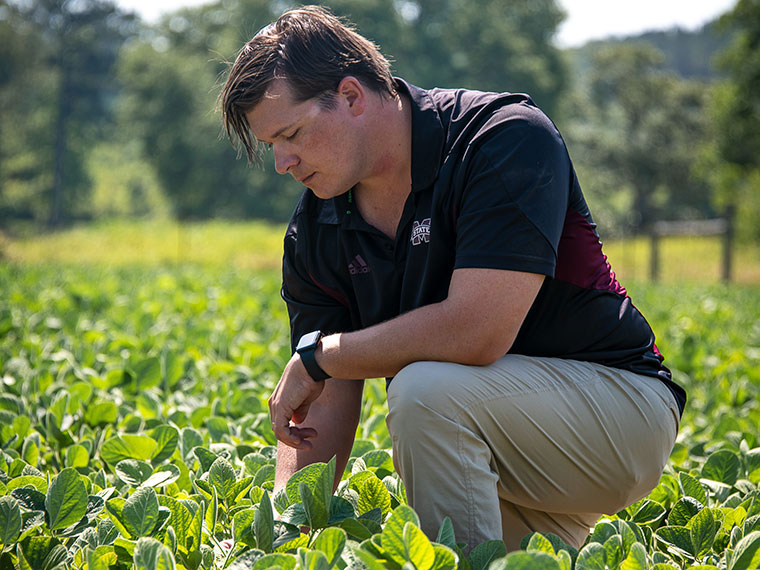The information presented on this page may be dated. It may refer to situations which have changed or people who are no longer affiliated with the university. It is archived as part of Mississippi State University's history.
For Florence, Alabama native, Forrest Davis, Mississippi State University's reputation for producing successful and innovative students in agriculture was a deciding factor for pursuing his master's degree in plant and soil sciences. Now he is becoming the innovator with a project focused on an integrated crop-livestock system.
As the world population increases, producers are faced with increasing pressure to farm more food on less land, with fewer inputs, higher production costs, and the overwhelming urgency to protect the land. Ensuring soil health to help farmers improve production and sustain the environment is a top priority for scientists in the Mississippi Agricultural and Forestry Experiment Station (MAFES).
Davis, under the direction of Dr. Brett Rushing, associate extension and research professor in plant and soil sciences and MAFES scientist, has been focusing on the effect of cover crops and livestock integration on crop growth.
"The opportunity to conduct hands-on experiments alongside professors allows me to understand the amount of work that goes into agricultural research at Mississippi State," said Davis.
Davis is observing the soil health effects of grazing cattle on cereal rye, a cover crop at the MAFES Coastal Plain Branch Experiment Station in Newton and the Prairie Research Unit in Prairie.
"Evaluating soil health parameters, cattle and soybean performance, and economic returns are important to our study," said Davis. "It will help us decide the practicality of adopting this type of system in Mississippi and other areas in the Southeast."
The Coastal Plain Branch Experiment Station is home to a beef cattle herd and row crops which allows Davis to assist researchers by collecting and recording data. Research at the Prairie Unit focuses on cattle and forages.
Davis said the key to healthy soil is to nurture chemical, biological, and physical processes that occur below the surface.
"The goal is to accelerate the spread of nutrients in the soil throughout the whole year," said Davis. "Keeping crops in the field year-round also potentially saves producers money by forgoing the purchase of cattle feed for the winter period."
Utilizing three different treatments based on a sustainable agriculture system has allowed the researchers to discover the effect of grazing livestock. One treatment was conventional soybean production with no cover crop, another treatment had soybean production plus a cereal rye cover crop in a no-till system, and the third treatment included soybean production and a cereal cover crop in a no-till system the livestock were allowed to graze.
Davis said the addition of grazing led to a $200 per acre economic advantage at the Coastal Plain Branch Experiment Station compared to the other two treatments due to animal performance on cover crops and greater soybean yields following grazing. However, at Prairie, Davis found that reduced soybean yields, and narrow winter grazing periods are limiting economic returns within the system.
Although another year is needed before determining the effectiveness of an integrated crop-livestock system, Davis hopes the research will allow producers to generate more revenue while creating a more sustainable production system.
"My favorite thing about research is being able to get out there and see a problem and be able to develop a solution in my mind and try it out," said Davis. "Taking a step back and realizing the producers are who we're doing this for is necessary. If we can clearly demonstrate that the system works, more producers may consider an integrated crop-livestock system."
Dr. Kelsey Harvey, assistant professor in animal and dairy sciences, who is stationed at Prairie; Dr. Josh Maples, assistant professor in agricultural economics; and Dr. William Kingery, professor in plant and soil sciences; collaborate on this work. This research is funded by the Mississippi Soybean Promotion Board.

